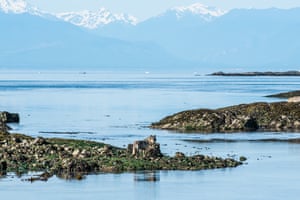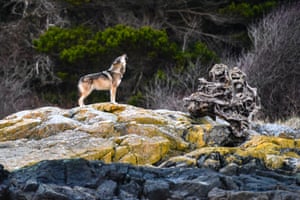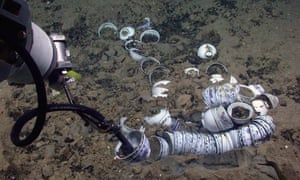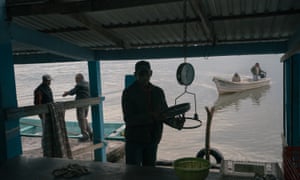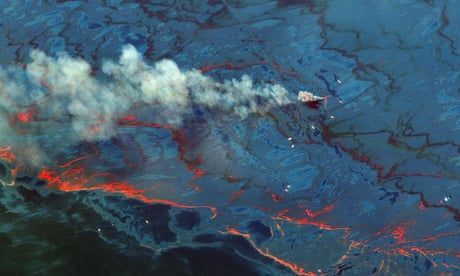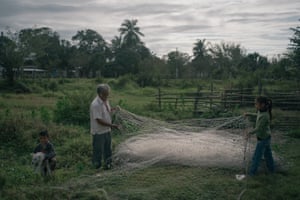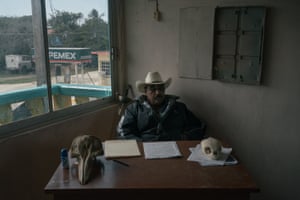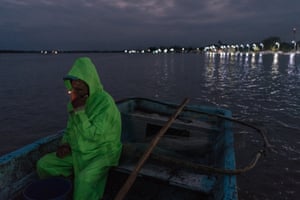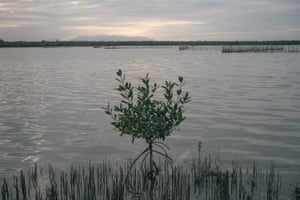Canada mourns Takaya – the lone sea wolf whose spirit captured the world Takaya on Vancouver Island, British Columbia.
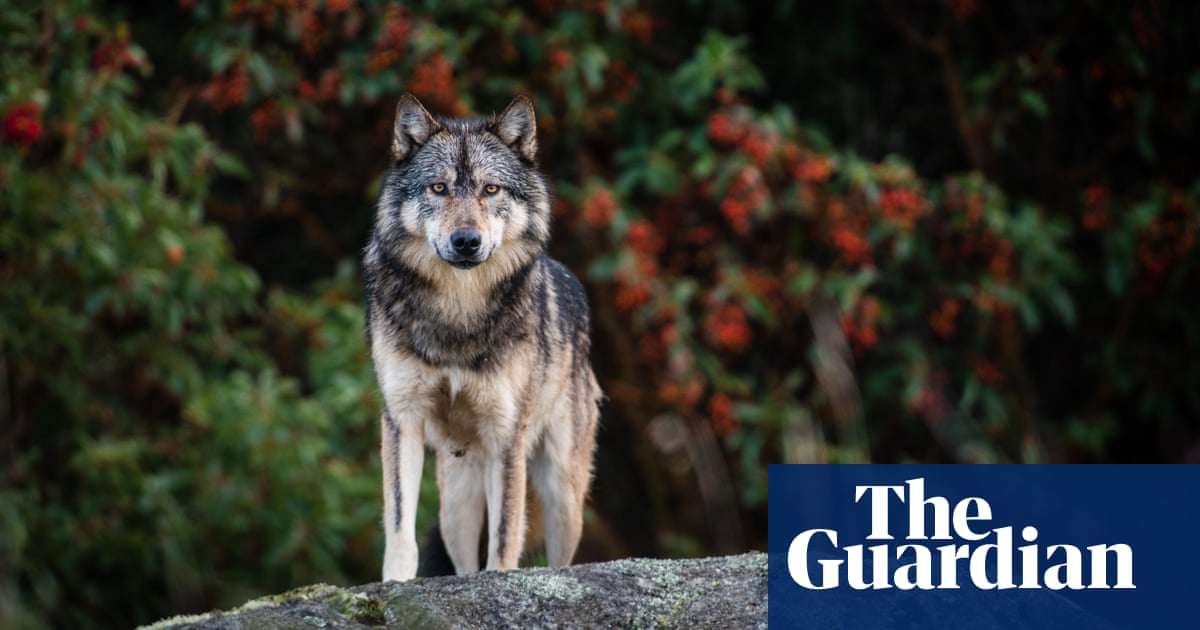
Photograph: Cheryl Alexander/Wild Awake Images
The life – and this week’s sudden death – of the legendary wolf shone a light on the often-strained bond between humans and wild animals
by Leyland Cecco
The age of extinction is supported by
.png) About this content
About this contentFri 27 Mar 2020
When Doug Paton burst from his trailer on a warm spring afternoon, he expected to confront yet another stray dog agitating the livestock on his sister’s farm outside Victoria, a city on Canada’s west coast. Instead, standing barefoot in the grass, he found himself face to face with a wolf.
“It stopped dead in its tracks and it stared me down,” he says. Then, as quickly as it appeared, the wolf trotted away, pausing once to stare back at Paton before clearing a five-foot metal gate and vanishing.
“Just like a person, you might not remember a name, but you never forget a face,” he says. “I’ll never forget that face as long as I live. I just close my eyes and see it.”

Doug Paton got a Lone Wolf tattoo to mark his encounter with Takaya. Photograph: Leyland Cecco
After leaving a breathless Paton back in 2012, the young wolf traversed nearly 25 miles of urban sprawl, taking shelter in the backyards and parks of British Columbia’s capital, until he reached the south-east tip of Vancouver Island. From there, the wolf swam nearly two miles towards a scattering of tiny islands within sight of the city.
In the eight years that followed, the wolf – named Takaya (the Lekwungen word for wolf) by the Songhees, a local First Nation whose territory encompasses the islands – quickly became a legendary figure, drawing fans from around the world captivated by stories of the resilience – and tenderness – of the young predator.
But his life ended in tragedy on Tuesday, in a series of events that laid bare both the cold uncertainties of life in the wild and the limits of an often-strained bond between humans and wild animals.
Two years after Paton’s experience, Cheryl Alexander got her first glimpse of Takaya, in May 2014. Like many of the 370,000 residents of greater Victoria, the environmental consultant and photographer was curious about how the wolf could survive among the wind-battered trees of the tiny islands.
Tayaka was a rare species of canine known as the coastal or sea wolf. These predators thrive in marine environments and have become adept at living off a diet of salmon, shellfish and seals instead of deer. Fifty years ago, there were few coastal wolves in the region, victims of overhunting and habitat degradation. Today an estimated 250 of them roam the 12,000 sq miles of Vancouver Island, a remarkable turnaround for the embattled predators.
Takaya swam two miles to a scattering of tiny islands. Photograph: Cheryl Alexander/Wild Awake ImagesShe saw Takaya emerge from the ocean briefly and slip into the trees. The piercing howls that followed were a chilling and powerful experience. “It had emotions associated with it that were very melodic,” she says. “Everyone was almost moved to tears.”
Much of the excitement surrounding Takaya came from the unlikeliness of his journey. Few wolves have ever traversed the heart of Victoria, and the islands Takaya took up residence on were tiny, 10 times smaller than the narrowest known range for a wolf pack in the wild.
Most notably, he arrived alone. Wolves almost always live in nuclear families; two parents and their pups. Occasionally, one will break away to form a new group. But the dangers of hunting – the sharp antlers and stomping hoofs of panicking animals – are often fatal for a lone predator. That Takaya travelled solo – and seemed content to remain alone – added to the myth and excitement.
In recent years, new housing developments have marched steadily outwards from Victoria, swapping land that was once forested and wild for cul-de-sacs and two-car garages.
But the chain of islands close to the city is a rare enclave of untamed nature. Pine and fir, punctuated by the rich amber hues of arbutus trees, create thick inland forests. Seals haul themselves on to the shores and small mammals – mink and otter – scurry among the rocks.
Takaya quickly got to work, feasting on the seals and otters and sharpening his ability to catch fast-moving fish. But with no permanent streams on the island, he also had to use his ingenuity to survive. Drizzly winters created temporary wetlands, but summers in the region are dry. In a move that astounded biologists, he began digging wells on the island.
“He really pushed the envelope of what’s possible ecologically, both in terms of how he made his living, and the small amount of space that he actually required to do so,” says Chris Darimont, a wolf expert at the University of Victoria and the Raincoast Conservation Foundation. Takaya was an “extreme data point” on the spectrum of anything researchers had previously encountered.
Much of the excitement surrounding Takaya came from the unlikeliness of his journey. Few wolves have ever traversed the heart of Victoria, and the islands Takaya took up residence on were tiny, 10 times smaller than the narrowest known range for a wolf pack in the wild.
Most notably, he arrived alone. Wolves almost always live in nuclear families; two parents and their pups. Occasionally, one will break away to form a new group. But the dangers of hunting – the sharp antlers and stomping hoofs of panicking animals – are often fatal for a lone predator. That Takaya travelled solo – and seemed content to remain alone – added to the myth and excitement.
In recent years, new housing developments have marched steadily outwards from Victoria, swapping land that was once forested and wild for cul-de-sacs and two-car garages.
But the chain of islands close to the city is a rare enclave of untamed nature. Pine and fir, punctuated by the rich amber hues of arbutus trees, create thick inland forests. Seals haul themselves on to the shores and small mammals – mink and otter – scurry among the rocks.
Takaya quickly got to work, feasting on the seals and otters and sharpening his ability to catch fast-moving fish. But with no permanent streams on the island, he also had to use his ingenuity to survive. Drizzly winters created temporary wetlands, but summers in the region are dry. In a move that astounded biologists, he began digging wells on the island.
“He really pushed the envelope of what’s possible ecologically, both in terms of how he made his living, and the small amount of space that he actually required to do so,” says Chris Darimont, a wolf expert at the University of Victoria and the Raincoast Conservation Foundation. Takaya was an “extreme data point” on the spectrum of anything researchers had previously encountered.
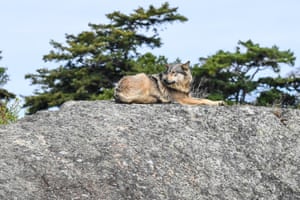
Takaya was known to dig wells to find drinking water in the dry summers. Photograph: Cheryl Alexander/Wild Awake Images
People began paddling out to the islands, hoping to catch a glimpse of this miraculous wolf thriving in the ever-vanishing wild around them.
But as his popularity grew, fed by a steady flow of stories in the local media, government authorities feared a dangerous encounter with humans had become inevitable and in the summer of 2012 and winter of 2013, conservation officers set up a series of traps. But Takaya seemed untrappable, ignoring the bait laid out for him.
Plans to capture Takaya put the province at odds with the Songhees First Nations, who vigorously protested the idea of removing the wolf. Long a symbol of the Lekwungen people, there was an excitement among the community that a wolf had finally returned.
Resistance to capturing the wolf also unearthed longstanding grievances over control of the islands. Known as Ti’ches in Lekwungen, the archipelago has long been a source of natural medicines found in the woods and fish in the surrounding waters. When the colonial government enacted a ban on traditional indigenous ceremonies in the 1800s, the Songhees would travel to Ti’ches to practise in secret.
Archival photographs show large wooden structures along the shore, all of which have long disappeared; dismantled, destroyed or stolen over the years. Today the Songhees own all of Chatham Islands and share a portion of Discovery Island with the province of British Columbia. But even the name of the area – Oak Bay Islands Ecological Reserve – remains a vestige of colonialism.
“There’s a huge piece of culture that’s not known or appreciated,” says Mark Salter, the former tourism manager for the Songhees Nation, who has worked to educate the public about the history of the islands. On numerous occasions, he has had to put out fires left by campers and pick up garbage left on the shore. “People invite themselves out here, not knowing this is reserve land. But they’re not welcome.”
In 2016, a group ignored a ban on bringing pets to the islands, travelling with their two dogs. As they walked through the forest, they soon realised they had acquired a third canine in their group. The group panicked and scrambled on to the roof of a nearby lighthouse building, where they called coastguard rescue. Armed conservation officers also arrived, prepared to deliver a fatal shot if needed. Takaya was spared, but the encounter chilled Salter, who worried the wolf’s fame, which only increased over time, could be his undoing.
Howls still echoing in her mind, Alexander began boating around the islands, eager to repeat her first encounter. This time she came prepared with telephoto lenses. Her early sightings of Takaya were rare and infrequent. He was ghostlike, quickly vanishing from view.
“There was something very captivating about him,” she says. “For whatever reason, I felt a really intense connection. I just wanted to learn about his life.” She returned to the islands week after week. With permission from the Songhees Nation, Alexander was able to set foot in the forests where Takaya often hid. Walking gingerly among the pine and fir, she could sense his presence, even as he remained camouflaged among the trees and tall grass.
Photographer Cheryl Alexander, centre, with biologists Thomas Riemchen and Sheila Douglas. Photograph: Leyland Cecco
He began appearing – and vanishing – more frequently. In their hundreds of encounters – including one in which he sat just three feet from her – Alexander felt drawn to his tenderness. “Wolves want what we want,” she says. “They play. They touch. They care deeply about other members of their family.” It was these human-like characteristics that moved people the most. His lonely howls could often be heard from the city during calm weather. Wolves, like humans, crave companionship in some form. As Takaya aged, outliving most wild wolves, he did so alone.
No wolf had ever been recorded living alone for so long, says Darimont. And lone wolves typically avoid howling, so as not to draw the attention of nearby packs. Nearly everything about Takaya, it seemed, was exceptional.
In 2019, a documentary featuring Takaya that Alexander helped produce aired in Canada and on the BBC, further cementing his fame.
Then, in February 2019, a lone female was spotted on the rocky shores of the mainland, across from where Takaya made his swim. Experts doubt she swam the channel – but her presence ignited hope that Takaya might soon be reunited with one of his own.
“There was something about his aloneness … his alienation from his own kind … that spoke to people’s own feelings of alienation and aloneness in the world,” says Alexander. “Plus, we’re all hopeless romantics.”
Plans to capture Takaya put the province at odds with the Songhees First Nations, who vigorously protested the idea of removing the wolf. Long a symbol of the Lekwungen people, there was an excitement among the community that a wolf had finally returned.
Resistance to capturing the wolf also unearthed longstanding grievances over control of the islands. Known as Ti’ches in Lekwungen, the archipelago has long been a source of natural medicines found in the woods and fish in the surrounding waters. When the colonial government enacted a ban on traditional indigenous ceremonies in the 1800s, the Songhees would travel to Ti’ches to practise in secret.
Archival photographs show large wooden structures along the shore, all of which have long disappeared; dismantled, destroyed or stolen over the years. Today the Songhees own all of Chatham Islands and share a portion of Discovery Island with the province of British Columbia. But even the name of the area – Oak Bay Islands Ecological Reserve – remains a vestige of colonialism.
“There’s a huge piece of culture that’s not known or appreciated,” says Mark Salter, the former tourism manager for the Songhees Nation, who has worked to educate the public about the history of the islands. On numerous occasions, he has had to put out fires left by campers and pick up garbage left on the shore. “People invite themselves out here, not knowing this is reserve land. But they’re not welcome.”
In 2016, a group ignored a ban on bringing pets to the islands, travelling with their two dogs. As they walked through the forest, they soon realised they had acquired a third canine in their group. The group panicked and scrambled on to the roof of a nearby lighthouse building, where they called coastguard rescue. Armed conservation officers also arrived, prepared to deliver a fatal shot if needed. Takaya was spared, but the encounter chilled Salter, who worried the wolf’s fame, which only increased over time, could be his undoing.
Howls still echoing in her mind, Alexander began boating around the islands, eager to repeat her first encounter. This time she came prepared with telephoto lenses. Her early sightings of Takaya were rare and infrequent. He was ghostlike, quickly vanishing from view.
“There was something very captivating about him,” she says. “For whatever reason, I felt a really intense connection. I just wanted to learn about his life.” She returned to the islands week after week. With permission from the Songhees Nation, Alexander was able to set foot in the forests where Takaya often hid. Walking gingerly among the pine and fir, she could sense his presence, even as he remained camouflaged among the trees and tall grass.

Photographer Cheryl Alexander, centre, with biologists Thomas Riemchen and Sheila Douglas. Photograph: Leyland Cecco
He began appearing – and vanishing – more frequently. In their hundreds of encounters – including one in which he sat just three feet from her – Alexander felt drawn to his tenderness. “Wolves want what we want,” she says. “They play. They touch. They care deeply about other members of their family.” It was these human-like characteristics that moved people the most. His lonely howls could often be heard from the city during calm weather. Wolves, like humans, crave companionship in some form. As Takaya aged, outliving most wild wolves, he did so alone.
No wolf had ever been recorded living alone for so long, says Darimont. And lone wolves typically avoid howling, so as not to draw the attention of nearby packs. Nearly everything about Takaya, it seemed, was exceptional.
In 2019, a documentary featuring Takaya that Alexander helped produce aired in Canada and on the BBC, further cementing his fame.
Then, in February 2019, a lone female was spotted on the rocky shores of the mainland, across from where Takaya made his swim. Experts doubt she swam the channel – but her presence ignited hope that Takaya might soon be reunited with one of his own.
“There was something about his aloneness … his alienation from his own kind … that spoke to people’s own feelings of alienation and aloneness in the world,” says Alexander. “Plus, we’re all hopeless romantics.”
Takaya’s howls could be heard in the city on calm days. Photograph: Cheryl Alexander/Wild Awake ImagesOthers found strength in the wolf’s solitude. Paton, whose spring encounter in 2012 was likely the first recorded sighting of Takaya, was locked in a bitter custody battle and divorce when the two crossed paths.
“I didn’t want to fight any more. And then I saw this lone wolf and thought, ‘If he’s healthy – if he’s doing fine by himself, then so can I,’” he says. “From that day forward, I just changed my attitude towards things. I stopped feeling sorry for myself. I felt more invigorated than ever to get things right in my life. And I never looked back.”
Soon after, Paton had the words “Lone Wolf” tattooed on his forearms in permanent tribute.
With all the success Takaya had enjoyed on the islands, no one is sure why, on 25 January this year, he dipped his 10-year-old body into the swirling emerald waters one last time and swam towards the city.
Emerging from the ocean on the opposite shore, he was greeted by a scene of parks and forest, interrupted by condominiums and family homes. Darimont believes the most likely reason, despite the popular conception of Takaya as a lonely figure, was that he was overcome by the annual hormonal urge to mate, which occurs in January.
“I suspect he gave up tranquil retirement on the islands to go find a mate,” he says. Conservation officers have their own theories. They believe a string of intense storms in the winter months, which had blown fierce winds across the islands, might have disrupted Takaya’s access to food. The greenery of city parks across the water and the potential of a new source of food might have been enough to lure a hungry wolf.
Takaya was spotted in Beacon Hill park, a sprawling green space in downtown Victoria. Photograph: Leyland Cecco
Alexander, however, rejects mating and food loss as likely explanations for Takaya’s journey. In the days leading up to his departure, trail camera images showed a healthy, robust wolf. And if the previous nine years of hormones hadn’t been enough to move him from the island in search of a mate, she wondered why – at nearly 11 years old – he suddenly felt the urge to leave. Instead, she feared he might have misjudged the swift ocean currents and been swept towards the mainland. Or that the sound of poachers on the island – hunting ducks in the winter – might have prompted the skittish wolf to seek refuge in the water.
“I doubt that he was intending to leave permanently. I just can’t see it. It was his territory. It was really the only thing he knew. He’d been there all of his life,” she says.
For nearly 48 hours, Takaya, briskly trotting through parks and along sidewalks, led police on a wild chase through the city.
The city remained transfixed as police posted the wolf’s progress on social media. Alexander remembers a night riddled with anxiety as she received constant updates on the chase. Eventually police tracked Takaya to a house, finding him wedged between a garage and a fence. Alexander pleaded with officials to let her see Takaya, but was held back. “I was nearby and I believe that he could smell me,” she says.
Takaya was sedated and carried upside down, his tongue hanging from the side of his mouth, and placed into a metal barrel.
After snapping photos of his limp body being carried away, Alexander returned home to celebrate her husband’s birthday and then went to bed. “The next morning, I just woke up, and cried,” she says.
Two days later Takaya was released back into the wild, emerging from the stupor of drugs on a gravel logging road. Conservation officers decided to relocate him more than 100 miles from the islands. He was moved inland, where the forest is thick and impenetrable, along the rugged west coast of Vancouver Island.
Away from the familiarity and comforts of his small islands, Takaya faced a daunting list of new threats. Packs of wolves in the area might kill him if their paths crossed. Leg-hold traps, laden with bait, might prove too tempting to a starving wolf. Even the new prey – elk and deer – were unfamiliar. “There was tons of stuff that he hadn’t had to deal with in his life,” says Alexander. “I was very worried.”
“I didn’t want to fight any more. And then I saw this lone wolf and thought, ‘If he’s healthy – if he’s doing fine by himself, then so can I,’” he says. “From that day forward, I just changed my attitude towards things. I stopped feeling sorry for myself. I felt more invigorated than ever to get things right in my life. And I never looked back.”
Soon after, Paton had the words “Lone Wolf” tattooed on his forearms in permanent tribute.
With all the success Takaya had enjoyed on the islands, no one is sure why, on 25 January this year, he dipped his 10-year-old body into the swirling emerald waters one last time and swam towards the city.
Emerging from the ocean on the opposite shore, he was greeted by a scene of parks and forest, interrupted by condominiums and family homes. Darimont believes the most likely reason, despite the popular conception of Takaya as a lonely figure, was that he was overcome by the annual hormonal urge to mate, which occurs in January.
“I suspect he gave up tranquil retirement on the islands to go find a mate,” he says. Conservation officers have their own theories. They believe a string of intense storms in the winter months, which had blown fierce winds across the islands, might have disrupted Takaya’s access to food. The greenery of city parks across the water and the potential of a new source of food might have been enough to lure a hungry wolf.

Takaya was spotted in Beacon Hill park, a sprawling green space in downtown Victoria. Photograph: Leyland Cecco
Alexander, however, rejects mating and food loss as likely explanations for Takaya’s journey. In the days leading up to his departure, trail camera images showed a healthy, robust wolf. And if the previous nine years of hormones hadn’t been enough to move him from the island in search of a mate, she wondered why – at nearly 11 years old – he suddenly felt the urge to leave. Instead, she feared he might have misjudged the swift ocean currents and been swept towards the mainland. Or that the sound of poachers on the island – hunting ducks in the winter – might have prompted the skittish wolf to seek refuge in the water.
“I doubt that he was intending to leave permanently. I just can’t see it. It was his territory. It was really the only thing he knew. He’d been there all of his life,” she says.
For nearly 48 hours, Takaya, briskly trotting through parks and along sidewalks, led police on a wild chase through the city.
The city remained transfixed as police posted the wolf’s progress on social media. Alexander remembers a night riddled with anxiety as she received constant updates on the chase. Eventually police tracked Takaya to a house, finding him wedged between a garage and a fence. Alexander pleaded with officials to let her see Takaya, but was held back. “I was nearby and I believe that he could smell me,” she says.
Takaya was sedated and carried upside down, his tongue hanging from the side of his mouth, and placed into a metal barrel.
After snapping photos of his limp body being carried away, Alexander returned home to celebrate her husband’s birthday and then went to bed. “The next morning, I just woke up, and cried,” she says.
Two days later Takaya was released back into the wild, emerging from the stupor of drugs on a gravel logging road. Conservation officers decided to relocate him more than 100 miles from the islands. He was moved inland, where the forest is thick and impenetrable, along the rugged west coast of Vancouver Island.
Away from the familiarity and comforts of his small islands, Takaya faced a daunting list of new threats. Packs of wolves in the area might kill him if their paths crossed. Leg-hold traps, laden with bait, might prove too tempting to a starving wolf. Even the new prey – elk and deer – were unfamiliar. “There was tons of stuff that he hadn’t had to deal with in his life,” says Alexander. “I was very worried.”
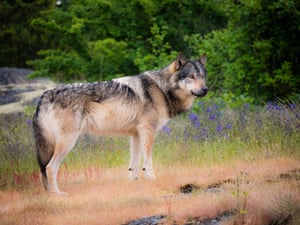 Takaya on Vancouver Island. Photograph: Cheryl Alexander/Wild Awake Images“Nature is nature and you can’t predict what’s going to happen,” said conservation officer Mark Kissinger, who tranquillised Takaya and set him free, at the time. “But hopefully things go well for him.”
Takaya on Vancouver Island. Photograph: Cheryl Alexander/Wild Awake Images“Nature is nature and you can’t predict what’s going to happen,” said conservation officer Mark Kissinger, who tranquillised Takaya and set him free, at the time. “But hopefully things go well for him.”Each time she visited the islands in the weeks that followed, Alexander was struck by an overwhelming sense of emptiness. “There’s an absence now of energy. There’s an absence of possibility,” she said, steering her boat through a narrow channel one sunny February afternoon.
“He gave us a portal into the wild and into nature – and into something that we often don’t get to see. And if we do, it’s only just a glimpse.”
Then, at the end of February, Alexander received an email from a woman who had spotted a wolf while out walking near the fishing community of Port Renfrew. It had peered at her from the forest and showed no signs of aggression when her dog approached it.
Alexander travelled to meet the woman but returned home without any sightings. Then, that night, she was sent a photograph from a man who had a series of trail cameras in the area. Alexander took one look at the picture, and recognised Takaya. A bright yellow tag was pinned in his ear – a souvenir from his experience with conservation officers.
Alexander travelled back to Port Renfrew, this time bringing her own trail camera. Checking it a few days later, the video showed Takaya walking past. The sighting, so close to a populated area, immediately concerned Alexander.
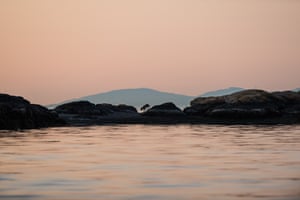
Takaya’s adventures ended when he was shot by hunters. Photograph: Cheryl Alexander/Wild Awake Images
“He doesn’t have that fear instilled in him that humans are bad. He’s trusting. It worries me he may find himself in a situation where humans are not all good and don’t have his interests at heart. It really scares me; it worries me,” said Alexander following the sightings.
Her instincts proved right.
On 24 March, Takaya was shot and killed, nearly 30 miles from where he was released. In the weeks before his death he had been spotted with increasing frequency, raising fears an encounter might prove fatal.
On his final day he came too close to a hunter’s dogs. In the end, it was his curiosity, built up from years of protection offered by the islands, that was his undoing.
British Columbia’s Conservation Officer Service told Canada’s CTV news: “We understand many British Columbians and people around the world shared care and concern for the wellbeing of this wolf and this update will affect many people.”
None more so than Alexander, who said simply: “It’s heartbreaking.”
“He doesn’t have that fear instilled in him that humans are bad. He’s trusting. It worries me he may find himself in a situation where humans are not all good and don’t have his interests at heart. It really scares me; it worries me,” said Alexander following the sightings.
Her instincts proved right.
On 24 March, Takaya was shot and killed, nearly 30 miles from where he was released. In the weeks before his death he had been spotted with increasing frequency, raising fears an encounter might prove fatal.
On his final day he came too close to a hunter’s dogs. In the end, it was his curiosity, built up from years of protection offered by the islands, that was his undoing.
British Columbia’s Conservation Officer Service told Canada’s CTV news: “We understand many British Columbians and people around the world shared care and concern for the wellbeing of this wolf and this update will affect many people.”
None more so than Alexander, who said simply: “It’s heartbreaking.”
---30---
